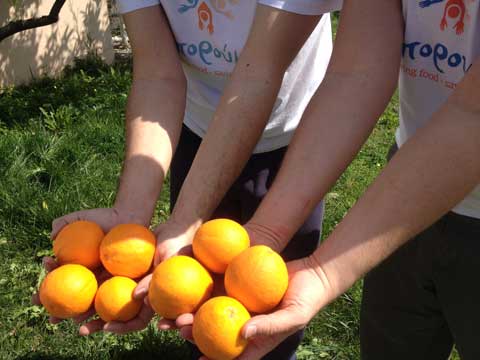- About
- Topics
- Picks
- Audio
- Story
- In-Depth
- Opinion
- News
- Donate
- Signup for our newsletterOur Editors' Best Picks.Send
Read, Debate: Engage.
| May 31, 2018 | |
|---|---|
| topic: | Food Security |
| tags: | #Colombia, #World Food Program (WFP), #United Nations High Commissioner for Refugees (UNHCR), #refugees |
| located: | Brazil, Colombia, Venezuela |
By Will Worley
CUCUTA, Colombia – In search of food, Yackeisy Uzcategui left Venezuela in 2017 with her husband and four children for Colombia. But hunger has followed them to the slum where they settled on the outskirts of Cucuta, near the Venezuelan border.
“If we have no work, we have no food,” Uzcategui told News Deeply. “Today we ate duck bones with our rice and beans. We asked our neighbour for them, we said it was for the dog.”
In oil-dependent Venezuela, a global decline in crude prices five years ago has spurred an economic collapse. Government-run assistance is disappearing, violence is increasing and inflation is rampant, spiking prices of even basic food items.
The situation has also spurred the largest migration crisis in the Western Hemisphere. Following a sharp jump in the second half of 2017, neighbouring Colombia has registered at least 660,000 Venezuelan migrants, though experts believe there could be up to a million in the country. And according to the World Food Program (WFP), 90 percent of the migrants arriving in Colombia said they left home because they could not get enough to eat.
Except most are not finding relief in Colombia. Work is hard to come by for many Venezuelans – particularly those without documentation – and poverty is rife. Experts are struggling even to quantify the scale of malnutrition they are contending with, let alone set up programs that can begin to address it. And those problems are exacerbated by the political situation in Colombia, where officials are grappling with different priorities.
“We need a food security response in Colombia to the displacement crisis,” said Jozef Merkx, the country representative for the United Nations High Commissioner for Refugees (UNHCR).
Rapid Relocation
In the midst of Venezuela’s crisis, experts have warned that the deaths of at least five children each week could be linked to malnutrition and 1.3 million people are undernourished. That has fueled an exodus from the country.
Estimates vary, but sociologist Tomas Paez of the Central University of Venezuela believes more than a million Venezuelans have migrated in the past two years. UNHCR is reporting that 800 people are fleeing daily to Brazil. But the majority are travelling southwest to Colombia.
Despite the high number of Venezuelan migrants in Colombia, malnutrition among the community is still largely unquantified. And there has not been an overarching, coordinated response to it – in stark contrast to other humanitarian emergencies. There have been no mid-upper arm circumference (MUAC) screenings – a standard way of detecting moderate (MAM) and severe acute malnutrition (SAM) in children. And Deborah Hines, the country representative for the WFP, said there are no global acute malnutrition rates available, which serve as a proxy for the health of the larger community and help guide a humanitarian response.
The extent of relevant data is a WFP survey of Venezuelan migrants. It registered very high levels of “food security at risk” in three border departments, along with the presence of over 20 percent “moderate” food insecurity and the presence of “severe” food insecurity.
Part of the problem arises from how quickly new arrivals scatter. Close to the border in Villa del Rosario, Jessica Dominguez and her 5-year-old daughter, Evangelie, finish their last meal of the day at the La Divina Providencia kitchen, run by Catholic relief organization Caritas. Dominguez crossed into Colombia from Venezuela last December and is one of the few who has remained at the border ever since.
“The only chance we have to eat is here,” said Dominguez, who works informally selling lollipops. “The money from selling candy is not enough to buy food, it only covers the room we stay in.”
Around 1,000 people a day come to La Divina Providencia for their breakfast and lunch, according to Paula Villamicar, who is the coordinator. Practically all of them are Venezuelan, she said, though many don’t stick around for long. Work is scarce in Cucuta, and undocumented migrants are unable to be employed legally. Relief workers say they are vulnerable to exploitation and even to forced recruitment by the armed guerrilla groups that stalk the area. Deportation sweeps also mean vulnerable migrants avoid making themselves known to the authorities.
“It’s very dispersed,” says Merkx. “It’s not like they have come just to one province, they are all over the place … where it’s easier for them to go unnoticed.”
Officials hope a nationwide registration program beginning this month will give them a better idea of the situation of Venezuelan migrants in Colombia, including their nutrition status. But because they are so scattered, some experts are sceptical that it will capture the full extent of the need.
Political Crises
The unique political situation in Colombia offers an additional barrier to collecting data on malnutrition and to mounting a response.
Colombian president Juan Manuel Santos’ government has prioritized implementing the 2016 peace accords with the rebel group the Revolutionary Armed Forces of Colombia (FARC). But an unexpected upswing in other guerrilla violence along with the influx of Venezuelan migrants late last year appears to have taken authorities by surprise – and overwhelmed Santos’ government.
“The Colombian state has many different problems: guerrillas, Colombian returnees, corruption, implementing the peace accords,” says Monsignor Hector Fabio Henao, director of Caritas Colombia, which has been running relief programs for Venezuelan migrants. “This uses a lot of energy and money.”
Programs that were assisting the migrants are now running out of resources. Just a five-minute drive from Yackeisy Uzcategui’s shack, a community kitchen stands locked up and unused. It used to feed 200 people a day, before the organization operating it ran out of money.
More help may be on the way. Last week, the WFP declared a “level two emergency,” which calls for regional support, and approved a plan to revise its country budget and “ensure immediate lifesaving food and nutrition assistance” to 350,000 people. These activities will be implemented at transit centres and among vulnerable communities. And there will be an emergency expansion of school feeding programs.
Even if the programs don’t reach Cucuta, Uzcategui doesn’t plan on returning home. “At least there is a chance to get money, work and food,” she said. “In Venezuela, there is no chance.”
“I’ve visited a number of these centres now,” the WFP’s Hines told News Deeply. “They don’t have sufficient resources.” And she acknowledges there is a funding gap, partly because of local government budget restrictions.
This article originally appeared on Malnutrition Deeply. You can find the original here. For important news about malnutrition and the ideas to end it, you can sign up to the Malnutrition email list.
By copying the embed code below, you agree to adhere to our republishing guidelines.

